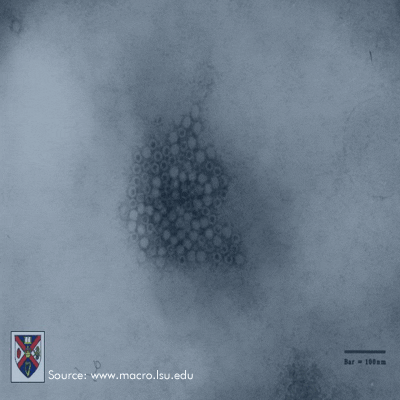
Get A Testing Quote
Canine Parvovirus
| Virus | Canine parvovirus |
| Structure | Non-enveloped |
| Family | Parvoviridae |
| Primary Host | Dogs |
| Disease(s) Caused | Intestinal disease, Congestive heart failure (Puppies) |
| Symptoms | Vomiting, Bloody diarrhea, Lethargy, Dehydration |
| Potential Complications |
Intestinal form: Sepsis, Cardiac form: Death |
| Transmission Mode |
Intestinal form: Fecal-oral Cardiac form: In utero, Fecal-oral |
| Sites of Community Outbreaks | Kennels, Animal shelters, Pet stores |
Importance of Canine Parvovirus
Canine parvoviruses (CPV-2a or CPV-2b) are highly contagious, and have been implicated as a primary source of acute disease in dogs since the late 1970’s. Most adult dogs that are infected with the virus remain asymptomatic, while puppies 6 to 20 weeks of ages generally present the most severe forms of illness. Puppies that have not been well-socialized nor received their first series of parvovirus vaccinations are particularly susceptible. Onset of acute illness follows an incubation period of approximately 3 to 7 days, and symptoms generally present in the intestinal form of the disease as lethargy, vomiting, and bloody diarrhea. Less commonly, pups will experience cardiac distress from canine parvovirus (parvo) infection and can die from sudden cardiac arrest. Even more rarely, puppies can be infected in utero if the mother experiences a parvovirus infection during pregnancy, resulting in severe neurological abnormalities observed upon birth (1).
Canine parvovirus is transmitted primarily via the fecal-oral route, and viruses are shed in exceptionally high numbers with the excretion of feces. The virus is then subsequently spread throughout the living environment. For example, a yard or enclosure containing even one infected dog will result in the contamination of multiple surfaces including organic (e.g. soil and grass) and inorganic (e.g. food and water bowls, artificial flooring, and walls). Dogs come into contact with these contaminated surfaces by way of a variety of activities, and the virus can be carried on fur, as well as paws. The innate tendency of canines to lick their paws and fur for cleaning (as well as licking the fur of other dogs) further contributes to transmission of the virus. Settings where dogs are housed in close proximity tend to see higher rates of parvo infection, and include breeding kennels, animal shelters, and pet stores.
The Importance of Disinfection: Survival of Canine Parvovirus on Surfaces and Transmission Potential via Fomites
An icosahedral, non-enveloped virus, canine parvovirus is one of the hardiest viruses known due to its exceptional resistance to environmental pressures (e.g. temperature extremes, seasonal variations, and desiccation). Parvo has been known to remain active in the environment for well over a year, particularly when associated with feces or other organic material (e.g. soil).
Canine parvovirus is also extraordinarily resistant to most household disinfectants. Household bleach has proven the most effective disinfectant for inactivation of the virus from potentially-contaminated surfaces, although the presence of protein may interfere with complete elimination (2). The robust nature of parvo has also made it a benchmark virus for disinfectant makers when modifying existing formulas, or developing new products to achieve optimal disinfection of surfaces. A disinfectant label claim granted for canine parvovirus demonstrates the potential capability of a test substance to inactivate the full spectrum of enveloped and non-enveloped viruses, whether easily inactivated or highly resistant.
References
- Decaro, N. and C. Buonavoglia. 2011. Canine parvovirus – A review of epidemiological and diagnostic aspects, with emphasis on type 2c. Veterinary Microbiology. 155: 1-12.
- McGaving, D. 1987. Inactivation of canine parvovirus by disinfectants and heat. Journal of Small Animal Practice. 28: 523-535.
Share

